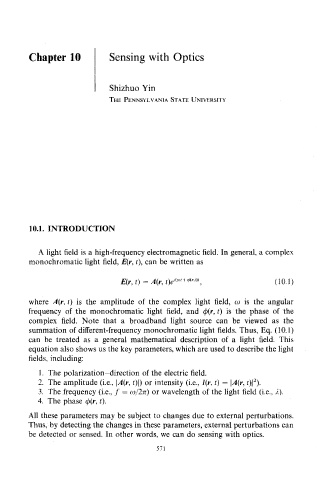Page 586 - Introduction to Information Optics
P. 586
Chapter 10 Sensing with Optics
Shizhuo Yin
THE PENNSYLVANIA STATE UNIVERSITY
10.1. INTRODUCTION
A light field is a high-frequency electromagnetic field. In general, a complex
monochromatic light field, E(r, t), can be written as
M+ (rJ)
E(r, t) = A(r, t)e* * >, (10.1)
where A(r, t) is the amplitude of the complex light field, co is the angular
frequency of the monochromatic light field, and 0(r, 0 is the phase of the
complex field. Note that a broadband light source can be viewed as the
summation of different-frequency monochromatic light fields. Thus, Eq. (10.1)
can be treated as a general mathematical description of a light field. This
equation also shows us the key parameters, which are used to describe the light
fields, including:
1. The polarization-direction of the electric field.
2
2. The amplitude (i.e., \A(r, t)\) or intensity (i.e., /(r, t) = \A(r, t)| ).
3. The frequency (i.e., / = co/2n) or wavelength of the light field (i.e., /,).
4. The phase 4>(r, t).
All these parameters may be subject to changes due to external perturbations.
Thus, by detecting the changes in these parameters, external perturbations can
be detected or sensed. In other words, we can do sensing with optics.
571

